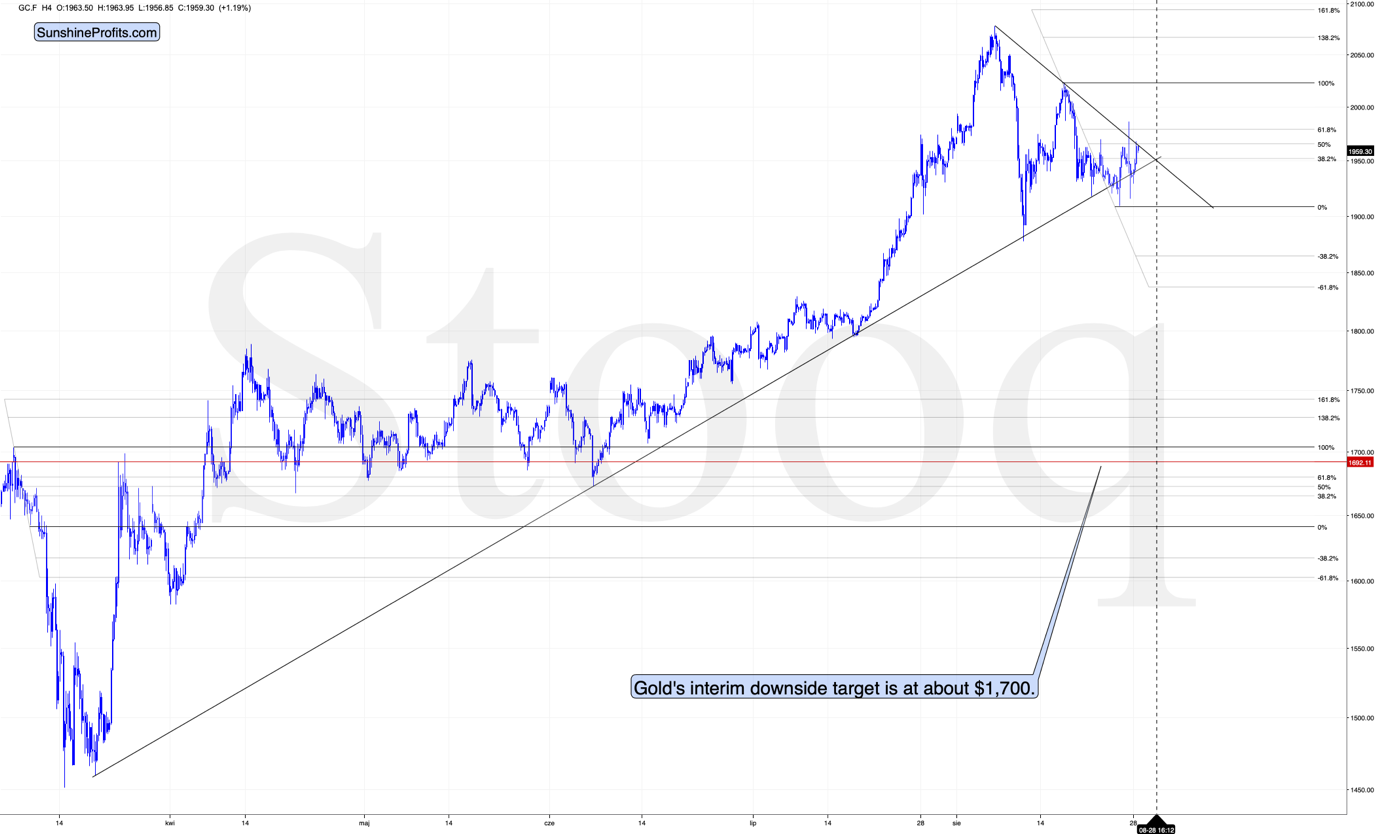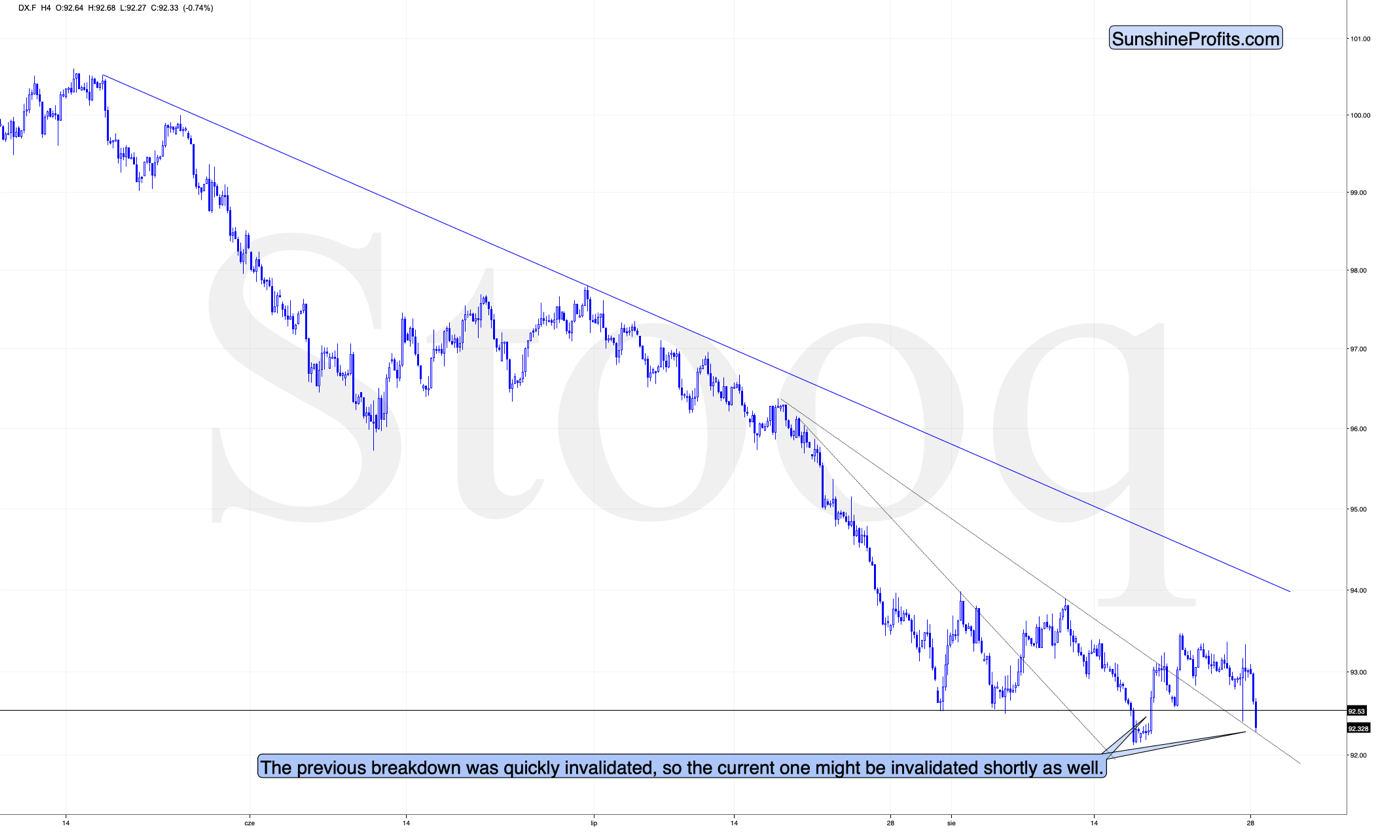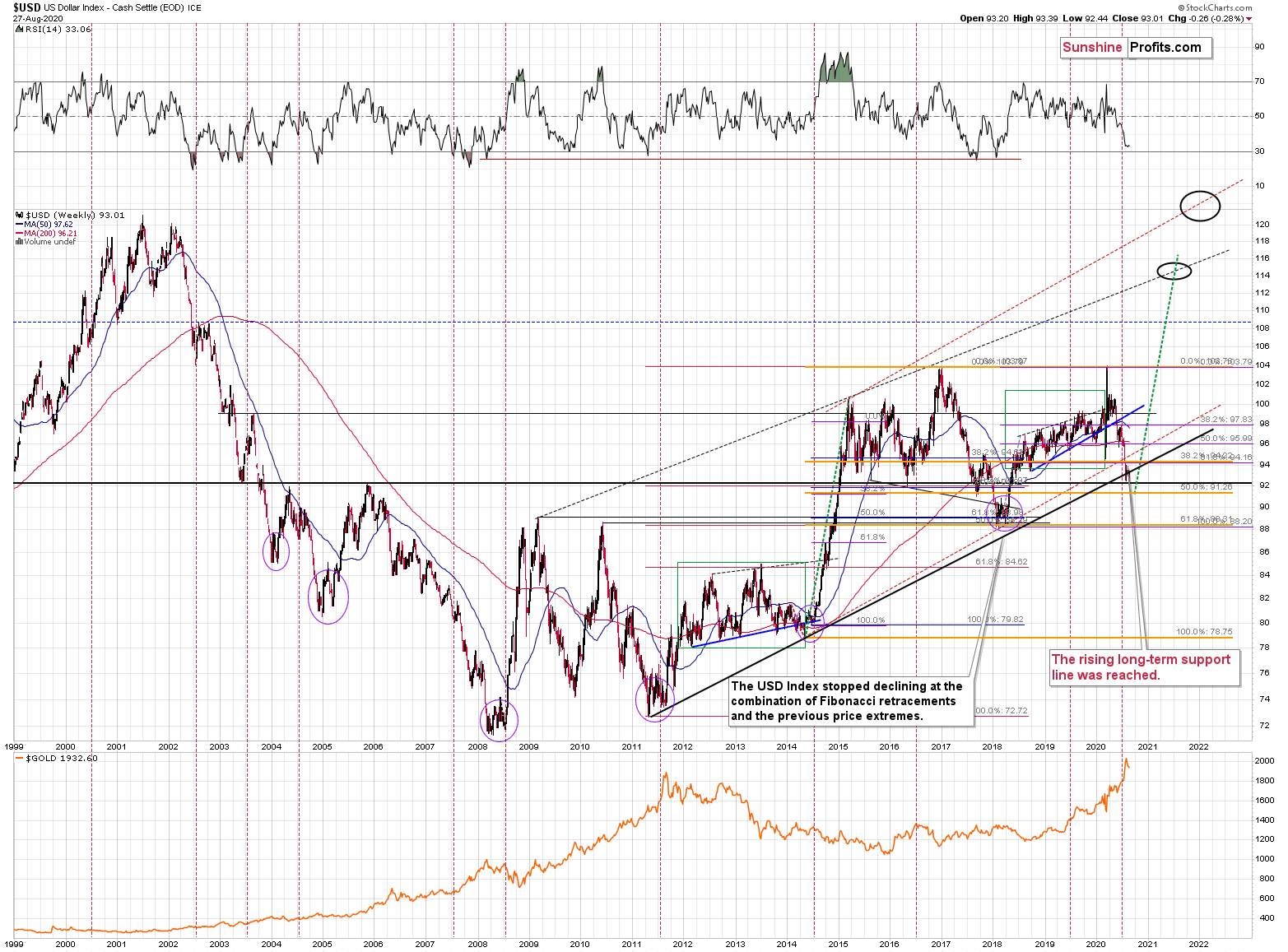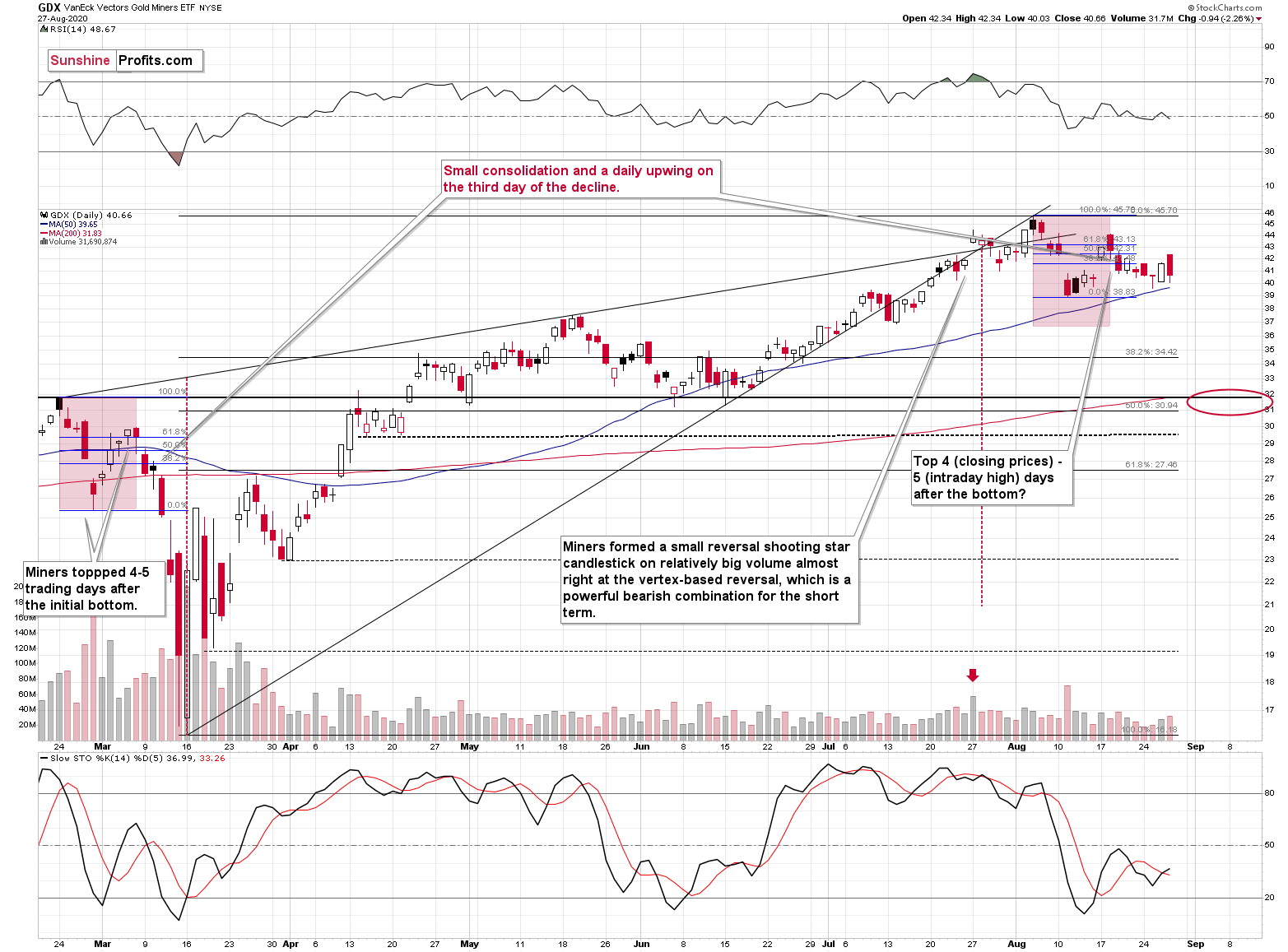Briefly: in our opinion, full (300% of the regular position size) speculative short positions in mining stocks are justified from the risk/reward point of view at the moment of publishing this Alert.
Gold rallied in the last couple of hours after a very volatile session yesterday. A lot certainly happened. But did as much change? Not really. Gold is trading below the declining resistance line and it's more or less at the price level that it reached several days ago. Consequently, nothing really changed from what we wrote previously:
Gold did move higher, likely responding to the intraday reversal in the USD Index, however gold's rally was nothing that would invalidate the similarity to its March performance. The general stock market didn't decline yet, so overall nothing really changed.
Back in March, after its final top and the initial decline, gold corrected a bit less than half of the downswing, before topping and moving lower.
It did exactly the same thing right now - gold corrected to almost the 50% Fibonacci retracement level based on the most recent decline. Consequently, nothing exceptional happened and the bearish implications of the recent double-top pattern remain intact.
Also, as you can see on the chart above, there's a vertex-based reversal "scheduled" for early next week. This means that if gold slides right now, it would be likely to form a local bottom in a few trading days. However, if gold rallies from here, such a move higher would likely be temporary.
In case of the U.S. currency, we did see another intraday breakdown below the previous lows, which means that the USD Index is also moving below the long-term support line visible on the below long-term chart.
This chart makes us doubt the seriousness and severity of this breakdown. The USD Index, being very oversold from the short term point of view, is unlikely to confirm the breakdown below the above-mentioned support levels.
Instead, it's much more likely that the breakdown will be invalidated, just like what we saw earlier this month. Back then, gold reacted to this invalidation by sliding visibly and we think the same thing is in the cards right now.
Please note that while the USDX moved close to its mid-August low, gold didn't move to its mid-August high. This is a sign that when the USDX invalidates the current breakdown, gold is likely to move below its August high. This would imply a breakdown below the medium-term support line that already worked several times. As such, this would be a very meaningful breakdown and something likely to be followed by an even more visible decline.
Thus, our outlook for the mining stocks remains largely unchanged. Namely, it remains bearish.
We previously wrote that due to stock market's (likely temporary, in my view) strength, the miners might not plunge just like they did in March, but pause for some time, and decline profoundly later. Quoting my previous analysis:
Last week, gold stocks rallied initially, but erased almost all of their gains before the week was over. Most interestingly, that's very much in tune with what happened in March.
Back then, on the third day of the decline - on March 10th - we saw a small daily upswing, which was just a daily pause right before the biggest part of the move.
We saw the same thing on Thursday. The GDX ETF moved a bit higher and it was the third day of the decline.
Just as we saw on March 10th, GDX moved higher on volume that was slightly lower than what we saw on the previous trading day.
On Friday - the fourth day of the decline - miners declined, more than erasing the previous day's gains. This is exactly what happened on March 11th - the fourth day of the previous decline.
The self-similarity remains intact and the implications remain very bearish.
Now, since the general stock market moved above the previous highs and continues to rally, we might or might not see a sizable decline early this week. Back in March, the slide in miners corresponded to the decline in the general stock market, and this could be repeated, or we could see some sideways trading after the slide resumes, once stocks finally decline.
Still, at this time, the implications of the above chart are very bearish.
Overview of the Upcoming Decline
As far as the current overview of the upcoming decline is concerned, I think that it has already begun, at least in case of the mining stocks. It's still relatively unclear if gold makes another attempt to move to new highs before plunging below $1,800, but it now appears more likely that it won't.
During the final part of the slide, we expect silver to decline more than miners. That would be in tune with how the markets initially reacted to the Covid-19 threat.
The impact of all the new rounds of money printing in the U.S. and Europe on the precious metals prices is very positive in the long run, but it doesn't make the short-term decline unlikely. In the very near term, markets can and do get ahead of themselves and then need to decline - sometimes very profoundly - before continuing their upward march.
Summary
Summing up, it seems that after reversing $4 above our upside target, gold has finally topped, and that it formed the second top from the double-top pattern last week. The opposite appears likely in case of the USD Index, which invalidated its breakdown below the previous lows - something that it's likely to repeat shortly with regard to the current move lower. This creates a very bearish environment for the precious metals market, especially for the mining stocks. The decline in the latter is likely to accelerate once the general stock market finally declines.
Naturally, everyone's trading is their responsibility, but in our opinion, if there ever was a time to either enter a short position in the miners or to increase its size if it wasn't already sizable, it's now. We made money on the March decline and on the March rebound, and it seems that another massive slide is about to start. When everyone is on one side of the boat, it's a good idea to be on the other side, and the Gold Miners Bullish Percent Index literally indicates that this is the case with mining stocks.
After the sell-off (that takes gold to about $1,700 or lower), we expect the precious metals to rally significantly. The final decline might take as little as 1-6 weeks, so it's important to stay alert to any changes.
Most importantly - stay healthy and safe. We made a lot of money on the March decline and the subsequent rebound (its initial part) price moves (and we'll likely make much more in the following weeks and months), but you have to be healthy to really enjoy the results.
As always, we'll keep you - our subscribers - informed.
To summarize:
Trading capital (supplementary part of the portfolio; our opinion): Full speculative short positions (300% of the full position) in mining stocks is justified from the risk to reward point of view with the following binding exit profit-take price levels:
Senior mining stocks (price levels for the GDX ETF): binding profit-take exit price: $32.02; stop-loss: none (the volatility is too big to justify a SL order in case of this particular trade); binding profit-take level for the DUST ETF: $28.73; stop-loss for the DUST ETF: none (the volatility is too big to justify a SL order in case of this particular trade)
Junior mining stocks (price levels for the GDXJ ETF): binding profit-take exit price: $42.72; stop-loss: none (the volatility is too big to justify a SL order in case of this particular trade); binding profit-take level for the JDST ETF: $21.22; stop-loss for the JDST ETF: none (the volatility is too big to justify a SL order in case of this particular trade)
For-your-information targets (our opinion; we continue to think that mining stocks are the preferred way of taking advantage of the upcoming price move, but if for whatever reason one wants / has to use silver or gold for this trade, we are providing the details anyway. In our view, silver has greater potential than gold does):
Silver futures downside profit-take exit price: unclear at this time - initially, it might be a good idea to exit, when gold moves to $1,703.
Gold futures downside profit-take exit price: $1,703
Long-term capital (core part of the portfolio; our opinion): No positions (in other words: cash
Insurance capital (core part of the portfolio; our opinion): Full position
Whether you already subscribed or not, we encourage you to find out how to make the most of our alerts and read our replies to the most common alert-and-gold-trading-related-questions.
Please note that the in the trading section we describe the situation for the day that the alert is posted. In other words, it we are writing about a speculative position, it means that it is up-to-date on the day it was posted. We are also featuring the initial target prices, so that you can decide whether keeping a position on a given day is something that is in tune with your approach (some moves are too small for medium-term traders and some might appear too big for day-traders).
Plus, you might want to read why our stop-loss orders are usually relatively far from the current price.
Please note that a full position doesn't mean using all of the capital for a given trade. You will find details on our thoughts on gold portfolio structuring in the Key Insights section on our website.
As a reminder - "initial target price" means exactly that - an "initial" one, it's not a price level at which we suggest closing positions. If this becomes the case (like it did in the previous trade) we will refer to these levels as levels of exit orders (exactly as we've done previously). Stop-loss levels, however, are naturally not "initial", but something that, in our opinion, might be entered as an order.
Since it is impossible to synchronize target prices and stop-loss levels for all the ETFs and ETNs with the main markets that we provide these levels for (gold, silver and mining stocks - the GDX ETF), the stop-loss levels and target prices for other ETNs and ETF (among other: UGLD, DGLD, USLV, DSLV, NUGT, DUST, JNUG, JDST) are provided as supplementary, and not as "final". This means that if a stop-loss or a target level is reached for any of the "additional instruments" (DGLD for instance), but not for the "main instrument" (gold in this case), we will view positions in both gold and DGLD as still open and the stop-loss for DGLD would have to be moved lower. On the other hand, if gold moves to a stop-loss level but DGLD doesn't, then we will view both positions (in gold and DGLD) as closed. In other words, since it's not possible to be 100% certain that each related instrument moves to a given level when the underlying instrument does, we can't provide levels that would be binding. The levels that we do provide are our best estimate of the levels that will correspond to the levels in the underlying assets, but it will be the underlying assets that one will need to focus on regarding the signs pointing to closing a given position or keeping it open. We might adjust the levels in the "additional instruments" without adjusting the levels in the "main instruments", which will simply mean that we have improved our estimation of these levels, not that we changed our outlook on the markets. We are already working on a tool that would update these levels on a daily basis for the most popular ETFs, ETNs and individual mining stocks.
Our preferred ways to invest in and to trade gold along with the reasoning can be found in the how to buy gold section. Additionally, our preferred ETFs and ETNs can be found in our Gold & Silver ETF Ranking.
As a reminder, Gold & Silver Trading Alerts are posted before or on each trading day (we usually post them before the opening bell, but we don't promise doing that each day). If there's anything urgent, we will send you an additional small alert before posting the main one.
Thank you.
Sincerely,
Przemyslaw Radomski, CFA
Editor-in-chief, Gold & Silver Fund Manager







